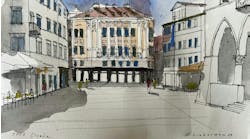Generation Z is on deck to enter the workforce, pushing millennials out of the spotlight and further augmenting the era of the five-generation workforce. References to an “evolving” office may not invoke the appropriate sense of urgency: Post-information age, the pace of workplace transformation is anything but glacial. The moment designers solve one workplace quandary, we must address another and another, and so on. With the advent of Gen Z entering the workplace, a host of new considerations about how, when, where, and why we work await.
As designers, we are not challenged to keep pace—we are tasked with shaping the future of work through a better built environment. Tomorrow’s workplaces must shift according to individual need (regardless of age, ability, or identification as an introvert or extrovert), support and contribute to employee health and wellness, and boost productivity and job satisfaction without sacrificing a core component of design—beauty.
Here, IIDA Executive Vice President and CEO Cheryl S. Durst, Hon. FIIDA, LEED AP, offers three insights that are driving workplace design.
The Human-Centered Office
WELL Building Standards are blazing a trail for human-centered workplaces—offering designers and clients benchmarks for everything from air quality
to the accessibility of nutritious food and water to incorporating fitness into the workday. WELL goes beyond the eco-friendliness and sustainability of building systems, furnishings, and materials to encompass a holistic office capable of cultivating healthy, happy, and productive employees.
“We have reached the collective realization that sustainability extends beyond the environment to the whole person,” Durst said. “We spend 90 percent
of our time indoors, so how we design a building is important, but how that design affects those who move through the building—that’s the question designers must answer now.”
Designing a human-centered workplace can attract and retain talent and encourage employees to be healthier and less stressed, which can add up to a big cost savings for employers over time. According to Durst, designers must make the case to their clients.
“If a company is going to invest in something, it should be their people, and the best way to invest in people is to support their health and well-being in the workplace. Design is step one.”
Your Company as Your Community
The conversation about branding and corporate culture has finally progressed, Durst noted. “The holy grail of branding is building a community around a company or product. Everyone wants to belong—it’s human nature.”'
Designers have long been incorporating an organization’s brand into workplace design to support, attempt to change, or to create a workplace culture, but true community goes beyond corporate colors, logo decals, and ping-pong tables.
“Social media has made it easy to opt out of offline relationships because we feel like we’ve engaged with others via comments and likes all day,” Durst explained. “But humans are social. We need face-to-face interaction, and the workplace is filling that void for many people.”
Harnessing the desire for community has the power to cultivate employee loyalty, engagement, productivity, and satisfaction. But community can’t be forced; instead, designers must create organic opportunities for employees to come together.
The Need for Beauty
In a tech-saturated world, many of us have become master multitaskers glued to our screens 24/7. This sounds productive, but research suggests the
opposite. And as we realize the toll hyper connectivity has taken, more people are seeking respite from the constant onslaught of information.
In response, beauty—the kind that engages all the senses—is poised for a comeback, and with it the reintroduction of texture, color, and craftsmanship.
“Creating beauty is a humanely essential part of what designers do,” Durst said. “You can create the most technically efficient and effective office in the world, but if it’s not aesthetically pleasing—no one will want to work there. Designing moments of beauty in a workplace encourages people to stop and reflect, and ultimately sparks inspiration. Beauty and authenticity are integral to making our workplaces more appealing and our employees happier and healthier. Beauty matters.”


